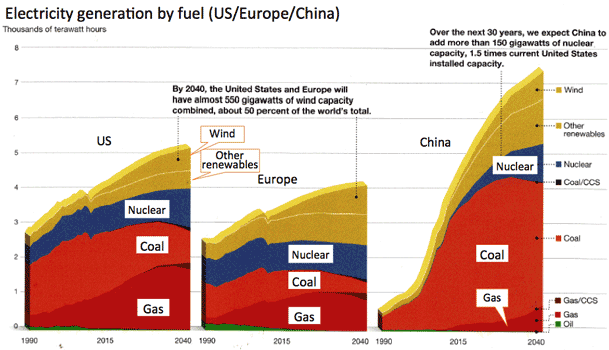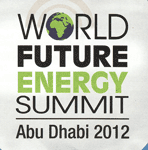 |
World Future Energy Summit, Abu Dhabi 2012
|
Category: ECO |
Kanzo Kobayashi |
12430u/18209r |
Title
World Future Energy Summit, Abu Dhabi 2012
世界未来エネルギーサミット
Index
Tag
Energy mix; Energy poverty; Extended Reach Drilling, ERD; Desulfuriztion; Carbon Capture & Storage, CCS; Hydraulic Fracturing; Global Warming Potential, GWP; ARPA-E; Challenging SWOT
Why?
- Seeing is believing; so Charting could be believing.
- 百聞は一見にしかず。百聞は一図にしかず。
Original resume
Japanese resume
>Top 0. Introduction:
- The fifth World Future Energy Summit (WFES) was held during January 16-19, 2012, which is regularly held in Abu Dhabi.
- The keynote speeches on the first day was given by Chinese Premier Wen Jiabao, Korean Premier Kim Hwangsik, as well as US Secretary General Ban Kimoon who attended the summit two years consecutively.
- Just before the opening, nervous news between US and Iran was reported, giving sensitive feelings around the Holmuz Straits near Abu Dhabi.
- Muhammad of Abu Dhabi Crown Prince representing host country declared opening of the summit. It is UAE's intention that they would host the summit as a show room for sustainable energy as long as their oil resources is sufficient.
- In sustainable energy, photovoltaic generation and wind generation are displayed in exhibitions as most promising alternative energy sources. But oil and natural gas majors emphasize traditional capability as the leaders in energy industry and experts in the Middle East. China and India who are consuming as much as half of world energy consumption, make efforts to secure new energy resources, showing their commitment in these areas backed by government support including environment issues.
- The summit looks like so-called "the Olympic games of present and future energy industries." The conference was first held after the Fukushima nuclear accident occurred in March 2011, drawing more attention to energy mix strategy, though UAE has signed to induce nuclear plants from Korea. The main theme seems how to secure natural gas, to realize rapid growth of sustainable energy and to pursue realistic scenario of less-nuclear dependent generation.
- It could have been good opportunity for Japan to appeal Japanese energy saving technologies and lessons from nuclear plants accident, but Japanese presence seemed less sufficient than those of EU, US, China, India and Korea.

0. 序文:
- 2012年1月16-19日UAEにアブダビ首長国連邦 (UAE)のアブダビ、再生可能エネルギーに関する国際会議「世界未来エネルギーサミット」が開催された。WFESは、毎年定期的にアブダビで開催され、今回で5回目になる。
- 会議の初日には、中国温家宝首相、韓国金滉植首相、さらに昨年に続いて2年連続で国連の潘基文総長が参加して基調講演を行った。
- 開催直前には、核開発に対する制裁などで米国とイランとの緊張する報道があり、UAEに近いホルムズ海峡での緊張が報じられた。
- ホスト国UAEからは、モハムド・アブダビ皇太子が開会を宣言した。UAEは、石油資源が豊かな内に、再生可能エネルギーのショールームへの意欲の表れだろう。
- 再生可能エネルギーでは、本命視される太陽光発電と風力エネルギーの急成長を示す議論と展示が多かった。一方で、中東拠点に実績を持つ石油・天然ガスのメジャーによる新技術など底力を示す場でもあり、さらに、中国・インドは、今後の自国のエネルギー需要が世界の半分に達すると見込まれる中で、エネルギー確保だけでなく、環境問題含めこの地域での役割を示したいとしていた。
- いわば中東を舞台に開催された、”現在および将来のエネルギー産業・オリンピック”のような会議であった。特に、2011年3月の福島第一原子力発電所事故後の会議でもあり、UAEが韓国からの原発導入を決め展示していたものの、主テーマとしてはエネルギーミックス戦略である。今後各国は、天然ガスの確保、再生可能エネルギーの成長性、脱原発の現実的シナリオをどう実現するかという課題に迫られている。
- 日本としても、中東を石油・天然ガスの供給先として見るだけでなく、日本の省エネルギー技術、原発事故の教訓などで、日本からの情報発信と国際貢献を示す格好の機会であったが、欧州、米国、中国、インド、韓国に比べて存在感が薄いように感じた。
>Top 1. Overview of UAE:
- The United Arab Emirates: attained independence in 1971.
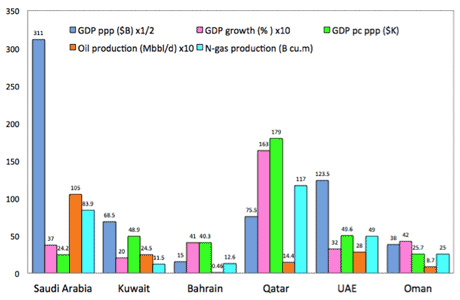
- Abu Dhabi
- Dubai
- Sharjah
- Ras al-KHaimah
- Ajman
- Fujairah
- Umm al-Quawan
- Abu Dhabi bears 80% of the federal budget:
- Population: 5.15M
- Abu Dhabi 0.66M,
- Median age 30.2
- Growth rate: 3.28%。UAE citizens: less than 20%
- Unemployment ratio: 12.5%;Gini coefficient: 36
- Islam: 96% (Shea 16%)
- Area: 83 km2
- Economy:
- GDP (real) $302B; GDP (ppp) $247B
- GDP per capita: $50,000 (no tax, no education, no medical fee)
- GDP growth: 3.2%
- Oil production: 2.8 Mbbl/d; Oil reserve: 95 years
- Natural gas: 48.8 Bm3; Natural gas reserve 132 years)
- Gulf Cooperation Council (GCC):
- composed of Saudi Arabia, Kuwait, Bahrain, Qatar, UAE, Oman
- regional cooperation of economy, trade, tourism, mining, agriculture, finance, investment, military:
- UAE and Qatar function as advanced window of the peninsula, just like that of Singapore.
- GCC six member countries share common interest of oil, ethnic group, religion, monarchy.
1. アラブ首長国連邦概略:
- 国名の英語表記はThe United Arab Emirates (UAE)、独立は1971年。
- UAEの構成国:
- アブダビ(Abu Dhabi), ドバイ(Dubai), シャルジャ(Sharjah), ラッセルハイマ(Ras al-Khaimah)、アジュマーン(Ajman), フジャイラ(Fujairah), ウンマル・カイワイン(Umm al-Quwain)の7ヶ国。
- アブダビがUAE予算の80%負担。金融・観光で先行するドバイを併せた2国が主要国。
- 人口:
- UAEは人口515万人、内、アブダビ66万人。
- 中位年齢 30.2
- 人口増加率 3.28% (2011)。人口に占めるUAE市民は20%以下。労働人口は370万人、内85%が外国人。
- 失業率は12.5%(女性は21.8%)。Gini係数36。
- イスラム教徒96% (内、シーア派16%)。
- 面積は、83 km2 (ほぼ北海道と同じ)
- 経済:
- GDP (real) $3020億、GDP(ppp) $2470億(2010)
- GDP (一人当たり) $50,000 (税金なし、教育・医療費無料であることを考慮すると実質はもっと高い。)
- GDP成長率:3.2% (2010)
- 石油生産:280万 バーレル(bbl)/d (2010)。確定埋蔵量 977 億 bbl (現在の生産量とすると95年分)
- 天然ガス: 488億 m3 (2009)、確定埋蔵量6.45 兆 m3 (同132年分)
- 湾岸産油国6ヶ国湾岸協力会議 (Gulf Cooperation Council; GCC)
- 加盟国は、サウジアラビア、クウェート、バーレーン、カタール、UAE、オマーン
- 経済・貿易・観光・鉱工業・農業・金融・投資協力・軍事 (テロ対策)・科学技術などでの協力が目的。
- UAEは、カタールと並んでアラビア半島の先進地域、いわば中東のシンガポール的役割
- 石油・民族・宗教・王政という共通性あり。
>Top 2. Key note of the first day:
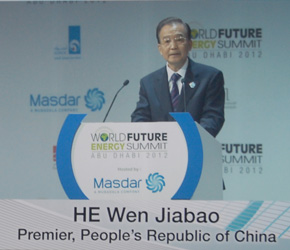 Wen Jiabao, Chinese Premier:
Wen Jiabao, Chinese Premier:
- Premier Wen visited UAE after Saudi Arabia, where he promoted active diplomacy including signing oil refinery plant at Yanbu industrial part; enabling to export refined oil from Red Sea side avoiding delicate Holmuz Straits.
- UAE also intends to install new pipeline to export from Oman Gulf side.
- Premier Wen emphasized to cooperate safety guarantee of the region as the permanent member of US Security Council.
- Chinese 12th Five Year Plan implemented last year, aims to reduce CO2 emission as much as 17% by 2015 as per GDP unit basis, also making sweeping changes in energy mix.
- The ratio of power generation by non-fossil fuel will increase 8.3 (2010) to 11.4% (2015), then to 15% (2020), actively invest $473B for sustainable energy, installing generation capacity up to 370GW by 2020.
- China has also become the world's fastest growing region in terms of wind and solar power: The ratio of renewable energy has been raised from 8.4% (2010) to 11.4% (2011), saving energy 20% less during the period from 2005 and 2010.
- The present generation capacity comprises hydraulic 200GW, wind power 47GW, solar power 3GW, as well as nuclear 10GW now and 27 new units are underway. In particular, offshore wind power sill raise from newly developed 300MW to 5GW (2015).
- China endeavors to promote new world of green and sustainable energy resources, pursuing international cooperation with other countries.
2. 初日の基調講演:
- 中国:温家宝首相
- サウジアラビア訪問に引き続き、UAEでのこの会議に参加した後、カタールも訪問した。
- 中国のエネルギー外交を積極推進していた。サウジアラビアでは、中国石油化工業団 (China Petrochemical Corporation, SINOPEC)とサウジアラムコ (Saudi Aramco)との合弁によるヤンブー工業団地での石油リファイナリー建設を調印したばかりで、これが完成すると東部の油田からパイプラインを経由して、石油精製を行い、ホルムズ海峡を通過せずに石油製品の輸出が可能になるので、地政学的な意味が大きい。
- 一方で、UAEも同様に、ホルムズ海峡を避けてオマーン湾までのパイプライン建設を急いでいる。
- 温家宝首相の基調講演骨子は以下の通りで、中国はこの地域の安定的な安全保障を国連常任理事国として指示するという姿勢を示した。
- 第12次五カ年計画では、CO2削減、Energy Mixを推進。CO2は2015年までに17%削減 (GDP単位当たり)する。
- 非化石燃料による発電比率は、 8.3% (2010) →11.4% (2015) →15% (2020)へと伸張。また再生可能エネルギーへ$4730億投資し、2020年までに発電容量370GW にする。
- 再生可能エネルギーの比率は、8.4%(2010)から11.4% (2011)へと急増し、GDP単位当り2005年から2010年の間に省エネルギー20%減を達成した。
- 現在の発電容量としては、水力200GW、風力47GW、太陽光3GW、原発10GWに加えてさらに27基が建設中。この内オフショア風力は、新規開発300MWから5GW (2015) へ増加する。
- 今後とも各国と協力し、New world of greenと持続可能な開発を推進する。
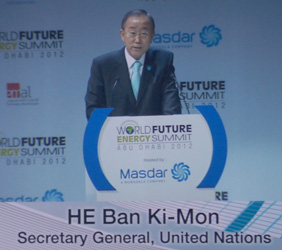 >Top Ban Ki-moon, US Secretary-General:
>Top Ban Ki-moon, US Secretary-General:
- 2012 is designated the UN International Year of Sustainable Energy for All, setting up UN millennium target year to develop sustainable energy as well as water and hygienic environment.
- Ban Ki-moon pointed out, "Widespread energy poverty still condemns millions to darkness, to ill health, to missed opportunities for education," adding that "one in five people in the world today still don't have access to modern electricity. "It is not acceptable that three billion people have to rely on wood, waste, and charcoal for their energy needs.
- He also stressed that three objectives had to be achieved by 2030 as the framework for action agenda;
- Ensuring universal accesses to modern energy services
- Doubling the rate of improvement of energy efficiency
- Doubling the share of renewable energy
- 国連の潘基文事務総長:
- 2012年は、国連が定める"すべての人のための持続可能エネルギーの国際年"であり、水・衛生などと並んでエネルギー問題も国連のミレニアム開発目標となっている。
- 国連の潘基文事務総長は、"地球温暖化の問題に加えて、今なおエネルギー・デバイドが深刻な課題であり、世界には、まだエネルギー貧国の国々があり、5分の1に電気供給がない。闇、貧困、教育の機会逸失の原因となっており、世界の30億人は薪に依存した生活を余儀なくされている"と述べ、WFESとして2030年までに達成すべき3目標を挙げた。
- 近代的なエネルギーへのユニバーサル・アクセス
- エネルギー効率を2倍にする。
- 再生可能エネルギーシェアを2倍にする。
>Top 3. Exhibition booth of each country:
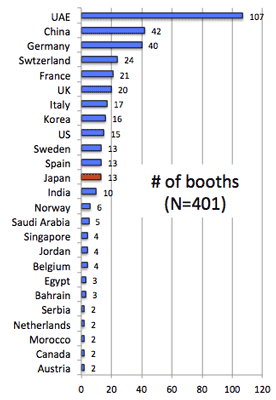 Number of booths by country:
Number of booths by country:
- many worldwide energy-related companies and organizations opened their booths at the summit.
- Each booth had miniature conferences on particular issues by specialists of each organization, together with having individual commercial talks.
- Representaives from Japan:
- From Japan, Mitsuyoshi Yanagisawa, vice minister of METI attended as a panelist of one of conferences.
- On Jan. 18, Kazuo Fukukawa of NEDO appeared as a panelist, saying that "sustainable energy needs to be promoted by government initiatives considering economic efficiency and energy mix strategy." The audience had expected more clear-cut messages from Japan after the Fukushima lessons.
- Japanese booths:
- counts 13, which are from Chiyoda Corp, Dentsu, Japan Oil Development, Japan Cooperation Center for Middle East, Japan Oil, Gas and Metals National Corp. (JOGMEC), Japanese Business Alliance for Smart Energy Worldwide (JASE-W), JGC Corp, Koberco-Solutions Co., Mitsubishi Heavy Industry and Mitsubishi Corp, New Energy and Industrial Development Organization (NEDO)、NGK Insulators, Okaya & Co., Yagai Tekko.
3. 各国の展示ブース:
- 国別出展ブース数:
- 地元UAE始め、欧州、米国、中国、インドなど世界のエネルギー関連産業、国際機関、大学・研究機関、金融、調査会社、メディアなど多様な企業が出展し、その代表が講演やパネリストとして参加した。また各ブースでは、それぞれの専門家による個別の小講演が随時行われ、熱心なQ&Aが行われていた。また立派な家具での商談コーナーも盛況であった。
- 日本からの代表:
- 初日のパネリストとして柳沢光美経済産業省政務官が参加した。
- 3日目の1月18日には、古川一夫独立法人新エネルギー産業技術総合開発機構(NEDO)理事長がパネリストとして参加、「新エネルギーは、いまだ経済性の課題および政策上の整合性が重要なので、公的機関の関与が引き続き必要である」と発言していた。
- 日本からの展示ブース参加企業・組織:
- 千代田化工建設株式会社、株式会社電通、ジャパン石油開発、財団法人中東協力センター、独立法人石油天然ガス・金属鉱物資源機構、世界省エネルギー等ビジネス推進協議会 (JASE-W)、日揮株式会社、株式会社神鋼ソリューション、三菱重工業株式会社/三菱商事株式会社、独立法人新エネルギー・産業技術総合開発機構(NEDO)、日本ガイシ株式会社、岡谷鋼機株式会社、合資会社谷貝鉄工所の13社
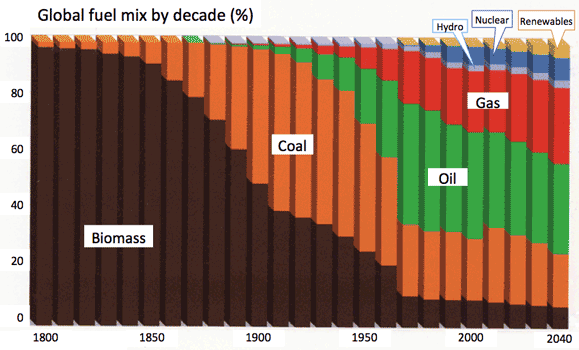
>Top 4. Noteworthy lectures:
- The following data is based on ExxonMobil's Outlook, which reveals many similarities with that of IEA's World Energy Outlook 2011.
- Source: ExxonMobil, 2012, The Outlook for Energy: A view to 2040:
- This is the History of Energy Utilization:
- The outlook of ExxonMobil looks persuasive. This energy sources contains not only power generation but also all energy consumption included, which says that still nearly 80% depends on oil, gas and coal in near future.
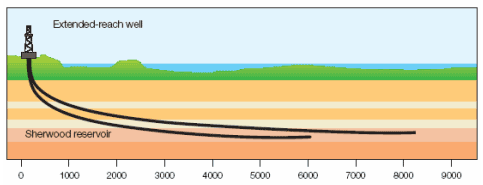 New technologies are developed to exploit fossil energy effectively; such as:
New technologies are developed to exploit fossil energy effectively; such as:
- Extended Reach Drilling (ERD), Desulfurization equipment. ERD has improved the yield ratio from 30% to 50-70%.
- Carbon Capture & Storage (CCS) technologies.
- Hydraulic Fracturing
- Micro-seismic imaging technology
- Shale gas (unconventional natural gas):
- North America has mostly developing shale gas. China is expect to have 1.5 times more reserves than US.
- It is advantageous to have shale gas reserves near consuming areas, and is expect to exploit economically using the latest technologies.
- The only concern is environmental issues; contamination to underground water by using hydraulic fracturing method, and possible emission of CO2 and methane (global warming potential (GWP) 21 times that of CO2) into atmosphere.
4. 注目すべき講演:
- エネルギーの利用がどのような変遷:
Global Fuel Mixの過去と将来予測の解説が、ExxonMobilの展示ブースの小講演で行われた。エネルギーの老舗らしく、グローバルな視点での客観的な数字は説得力があった。
- グローバル燃料ミックス:
世界において (発電に限らず)利用されるすべての燃料ミックスは、2040年という近未来においても、石油・天然ガス・石炭への依存が80%と大きい。これらの化石燃料については、採掘技術の向上 (水平抗井技術)、脱硫装置に加えて、CO2を回収して地中などに閉じ込める技術 (Carbon Capture & Storage, CCS)の導入など。
- シェールガス、シェールオイルへの期待:
シェールガス、シェールオイルは、現状は米国の生産量が多いが、中国はその1.5倍の埋蔵量が期待されている。メリットは、近年の技術進歩による低コスト生産で、かつ消費地に近いことである。付加価値の高い軽質原油・ガスだが、環境問題がある。水圧破砕法による地下水汚染や環境へのメタンガス漏出 (温室効果=地球温暖化係数GWPはCO2の21倍)は大きな課題である。
- >Top
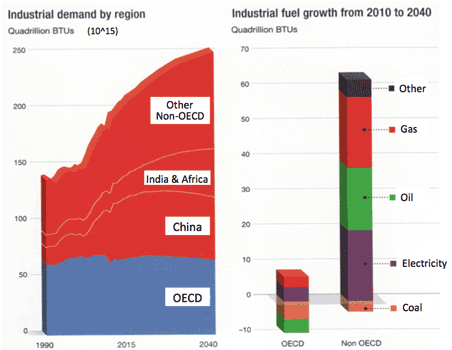 Industrial demand by region:
Industrial demand by region:
- The industrial sector (particularly plastics, steel and textiles) consumes nearly as much energy and electricity as the transportation, residential and commercial sectors combined.
- In OECD, industrial energy demand is expected to remain largely unchanged through 2040.
- By 2040, Non-OECD countries will account for 75% of global industrial demand, up from 65% today.
- China's demand peaks around 2030.
- India's demand will triple from 2010 to 2040.
- Growth is met mostly by electricity, oil and natural gas; coal will decline.
- Global industrial demand for electricity will rise by 80% through 2040.
- Strong growth is seen in oil and natural gas, whose industrial demand grows by 50% through 2040.
- エネルギーの国別需要予測:
- 産業用 (化学、鉄鋼、線維等)のエネルギーは、輸送+家庭+サービス分野の需要とほぼ同じ。
- OECD諸国は、2040年まで産業用の需要はほぼ横ばい。
- 中国・インドを含め、非OECD諸国の産業用エネルギー需要は、現在の65%から、2040には75%にも達する。
- その多くが発電用エネルギーの伸びによる。石炭依存は減少し、石油と天然ガスの需要が増える。
- 発電用エネルギーの利用は2040年までに80%に達する。石油と天然ガスへの需要は旺盛で、2040年までに50%に達する。
- 中国の需要のピークは2030
- インドの需要は2010-40で3倍
- >Top ELectricity generation by fuel:
- US and Europe continue to shift to lower-carbon sources for electricity; China's coal usage shrinks after 2030.
- Today, Europe gets about half its electricity from nuclear and renewable fuels. Strong growth in wind power, which will account for 20% of Europe's power by 2040, up form 5% currently.
- US exhibits similar trends, although US will see much steeper growth in domestic unconventional gas.
- China's electricity demand will more than double by 2040, which will shift its electricity generation away from coal.
- OECD CO2 costs reaching $80/ton by 2040. Non-OECD countries will begin adding CO2 costs around 2030.
- 発電ソース別予測 (2010):
(単位:千TWh)
- 欧米は、発電ソースは低炭素燃料へシフトする。中国も2030以降は石炭火力減少。
- 欧州では、今日、半分の電力は原子力と再生可能エネルギー。特に風力発電の伸びが顕著で、現在の5%から、2040年までに20%に。
- 米国も同様の傾向だが、特に、自国の非在来型天然ガスの利用が活発。
- 中国では、発電量の急増し、2040年までに倍増の見込み。なお、石炭火力への依存は減少。
- OECDは、CO2除去費用は$80/tonの見込み。中国がこの設備を本格導入するのは2030年頃と予想される。
- >Top If you are CEO of an electric utility, what type of fuel would you design, with the goal of providing reliable, affordable electricity to you customers over decades of operation?
- Cost, availability and diversity of fuels:
Today, in most countries, natural gas and coal are the most economic options for new power plants, followed by nuclear and wind. Economics also are influenced by utilization rates, because while a nuclear plants uses about 90% of its capacity to make electricity, utilization rates are much lower for wind and solar because they are intermittent sources. Availability and diversity of supplies also matter, as countries seek to enhance energy security.
- Policies to reduce CO2:
By 2040, OECD countries will have a cost of CO2 of $80 a ton. China will introduce more modest measures around 2030, followed by other Non-OECD nations.
- Construction cost and timelines:
It costs $1B or more to build a new 1GW power plant. Coal and nuclear plants can take more than five years for permitting and construction. In contract, most natural gas and renewable plants can be permitted and erected in less than two years.
- Technologies and consumer attitudes:
New technologies can lower costs, as unconventional production has done for natural gas in US. Public sentiment also matters. For example, Japan's Fukushima disaster is expected to slow global growth in nuclear capacity.
- Conclusion:
Taking together, these factors point to a continued shift to lower-carbon fuels, particularly natural gas. Gas emits up to 60% less Co2 emissions than coal. Gas-fired generation plants are based on proven technology, can be built quickly and are cost effective today.
もしあなたが電力会社のCEOならどの燃料での発電所を建設するか
- コスト、燃料供給可能性:
現在多くの国では、ガスと石炭火力を選好する傾向。但し稼働率が問題。原子力は稼働率90%が見込めるが(?)、風力・太陽光は稼働率が低い。
- CO2削減:
OECD諸国は2040年までに#80/トン負担となろう。中国なども2030年頃には追従。
- 建設コスト・建設期間:
1GWの発電所のコストは約$1Bかかる。石炭と原子力の建設期間は5年以上。ガスと再生可能エネルギーは2年以上。
- 技術および顧客の反応:
新技術によってコストは変動する。顧客の意識も重要。とくに福島原発事故の影響あり
- 結論:
低炭素燃料へのシフトが進行。特にガスへの選好。ガスは既存技術で建設でき、石炭火力に比べCO2排出量が60%。また建設期間も短い。
- >Top Share of Global Final Energy Consumption, 2009
- Source: REN21, Renewables 2011, Global Status Report
- Global energy consumption: rebounded in 2010 after a downturn in 2009.
- Renewal energy continued its strong growth in 2010: supplied 16% of global final energy consumption - counting traditional biomass, hydropower, wind, solar, geothermal, modern biomass, and biofuels.
- Renewable energy replaces fossil and nuclear fuels in four markets: power generation, heating and cooling, transport fuels, and rural/off-grid energy services.

- 世界最終エネルギー消費シェア
(2009)(左図) :
- 化石燃料 81%
- 再生可能エネルギー 16%
- 原子力 2.8%
- 世界の発電生産シェア (2010):
- 化石燃料67.6%
- 再生可能エネルギー19.4%
- 水力 16.1%
- 非水力 3.3%
- 原子力 13%、
- 非水力の再生可能エネルギーは、2009年比で25%増大し、計312GWとなった。
- 非水力の再生可能エネルギー 312GWの国別発電容量のトップ5は、米国、中国、米国、ドイツ、スペイン、インドである。水力を含めると、中国、米国、カナダ、ブラジル、インド、ドイツとなる。
- エネルギー最終消費の現状:
- 前年よりリバウンドし2009年比で5.4%増大。この内再生可能エネルギーの比率は16% (2009)
- 再生可能エネルギーは、発電、加熱・冷却、輸送、地方の独立エネルギーの4分野で化石や原子力を代替した。
- 最終消費エネルギーで見ると原子力の比率は2.8%に過ぎない。
- >Top
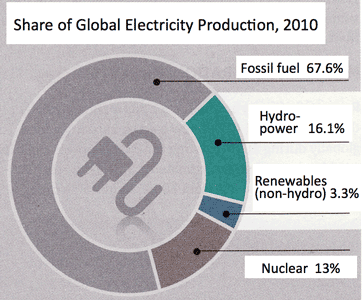 Share of Global Electricity Production, 2010
Share of Global Electricity Production, 2010
- World Total (GW) of Renewable Electric Power Capacity (End of 2010)
- Cf: World Power Generation Capacity, 2011 (source: Schneider Report, 2011 after Fukushima accident)
- Wind: 193GW
- Biomass: 65GW
- Solar: 43GW
- Nuclear: 375GW (437 reactors)
- renewable energy accounted for half of 194GW of new electric capacity added globally during 2010.
- Existing renewable power capacity worldwide reached 1,320GW in 2010, up almost 8% from 2009.
- Renewable capacity comprises about a quarter of total global power generating capacity (4,950 GW in 2010), and supplies close to 20% of global electricity, with most of this provided by hydropower.
- Except hydropower, renewables reached a total of 312GW, 25% increase over 2009 (250GW).
- Among all renewables, global wind power capacity increased the most in 2010, by 39GW. Hydropower capacity increased by 30GW during 2010, and solar PV capacity increased by 17GW.
- The top five countries for non-hydro renewable power capacity were US, China, Germany, Spain, and India.
- Including hydropower, China, US, Canada, Brazil, and India ties with Germany, were the top countries for total install renewable energy capacity by the en of 2010.
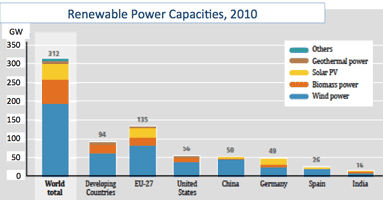 Renewable Power Capacities excluding hydropower, Developing world, Eu, and top Five countries in 2010:
Renewable Power Capacities excluding hydropower, Developing world, Eu, and top Five countries in 2010:
- 世界の発電シェア:2010
- 再生可能エネルギーの発電容量は(1,320GW/2010)で、世界の発電容量4,950GWの26%もあり、世界発電量の20%を発電。但し多くは水力発電による。
- 水力を除くと、再生可能エネルギーは合計312GW(2010)となり、前年の250GWより25%増加
- その中の伸び(2010)では、
-
風力:39GW増加
-
水力:30GW増加
- 太陽光17GW増加
- 非水力再生可能エネルギーのトップ5は、米、中、独、西、印
- 水力を含む再生可能エネルギートップ5は、中、米、加、伯、印と独は同率。
Wind
198
Biomass
62
Solar PV
40
Geothermal
11
Solar thermal (CSP)
1.1
Tidal
0.3
(Sub-Total)
312
Hydro
1,010
Renewable Total
1,320
Nuclear
375
Total Power generating capa.
4,950
>Top Wind Power Generation:
- New wind power capacity reached from 159GW in 2009, to 198GW increasing 39GW in 2010: almost 3 times growth compared five years ago.
- Compound Average Growth Rate (CAGR) is 27% from 2005 to 2010.
- (198-59.3)^(1/5)=1 = 0.2726
- China is the fastest growth: added 18.9GW in 2010 reaching 44.7GW.
- More than 30% of China's installed capacity was in the Inner Mongolia Autonomous Region followed by Gānsù (10%), Hébĕi (10%) and Liáoníng (9%) provinces.
- US added 5GW in 2010, reaching 40.2GW. By the year-end, wind accounted for 2.3% of electricity generation.
- Eu install nearly 9.5GW in 2010, totaling about 84GW. for the first year since 2007, wind power did not account for the largest share of new electricity capacity additions and came in third behind natural gas and solar PV. Germany maintaining the lead in EU, totaling 27.2GW at the end of 2010.
- 風力発電:
風力発電容量は、2009年の159GWから、2010年には39GW増加し、合計198GWになった。これは再生可能エネルギーの中で最大の伸びで、5年前に比べて3倍の増加。2005-2010の間のCAGRは27%
- 中国:その中でも風力発電容量は2009年に比し、2010年は37% (18.9GW)と最大の伸びで、計44.7GWに達した。
- 米国は、2010年の伸びは5GWと若干伸び、全体の風力発電容量は40.2GW。
- EUは、2010年の伸びは9.5GWで全体の風力発電容量は84GW
(この内、独だけで、27.2GW)
- なお、風力発電容量の国別トップ10は、中、米、独、西、印、伊、仏、英、加、デンマークで、日本はこの10位内にも入らない。
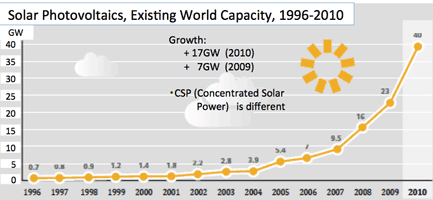

- >Top Solar Photovoltaic Power, Existing World Capacity, 1995-2010:
- Solar PV capacity was added in more than 100 countries during 2010; fastest growing power generation technology.
- 17GW capacity was added in 2010, compared with just under 7.3GW in 2009, totaling globally 40GW.
- Total existing capacity of all PV grew 73% relative to 2009; CAGR from 2005 to 2010 was 49%.
- EU dominated the global PV market, accounting for 80% of world total 13.2GW newly installed. For the first time ever, EU added more PV than wind capacity during 2010. Germany added more PV (7.4GW) in 2010.
- Japanese (3.6GW) and US (2.5GW) PV markets almost doubled relative to 2009. At least 5.4GW of additional US capacity was under contract by year-end. California still leads the nation with 30% of the market:
- Re: US and Japanese figures seem much lower than their potentialities.
- 太陽光発電 (PV)の累積設備容量の推移 (1996〜2010)
- 太陽光発電 (Photovoltaics, PV)と、太陽熱発電 (Concentrated Solar Power, CSP)とがある。前者は、太陽電池による発電、後者は、レンズ・反射鏡を用いた汽力発電
- PVが技術革新もあり、再生可能エネルギーの中では最も伸びている。世界全体で、2009年の7.3GWから2010年には17GWも増加し、合計40GWに達した。これは5年前の7倍。
- EUは、世界PV市場の80%(32GW) を占め、その内、2010年は独だけで世界のPVの伸びの半分以上を示し、独の発電容量は17.3GWになった。
- 欧州以外では、日本 (3.6GW)と米国 (2.5GW)もそれなりに健闘しているが、まだ本来の実力を発揮できていない。
- >Top
 Photovoltaic Solar Resources (kWh/m2/day):
Photovoltaic Solar Resources (kWh/m2/day):
(Source: SEA presentation at WFES, 2012 )
- Solar energy is stronger in lower latitudes. In term of the unit of kW/m2/day, Germany is lower than 3.0, while South-West of US shows more than 6.0. Arabian peninsular become around 7.0 to more than 8.0. When the presenter explained this story, many Arabian audience welcomed the speech with applause. Their daily blazing sun in the desert could become enormous resources for solar generation.
- 太陽光の資源 (kWh/m2/day):
太陽光発電の資源は、太陽の熱であるので、低緯度の国が有利。上記単位で比較すると、ドイツの場合は3.0以下に対し、米国の西南部では、6.0以上となり、アラビア半島では、7〜8.0以上となる。この話をした際、アラブ系の聴衆から大きな拍手が起きた。連日の灼熱の砂漠が、太陽光発電にとっては大変な資源となるというであるから無理もない。
- >Top Global New Investment in Renewable Energy :
Source: UNEP, Global Trends in Renewable Energy Investment 2011.
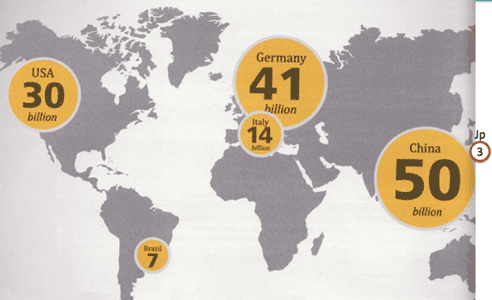
- Global investment in renewable energy, including financial new investment and small-scale investment - jumped in 2010 to a record $211B.
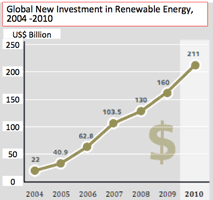 The top countries in 2010 ware China, Germany, US, Italy, and Brazil. For the first time, financial new investment in renewable energy in developing countries surpassed that in developed economy. (not included in the financial new investment measure, namely small-scale projects and R&D, developed countries remain well ahead)
The top countries in 2010 ware China, Germany, US, Italy, and Brazil. For the first time, financial new investment in renewable energy in developing countries surpassed that in developed economy. (not included in the financial new investment measure, namely small-scale projects and R&D, developed countries remain well ahead) - China attracted nearly $50B, making it the leader for the second year in a row.
- Japan: only $3.3B investment in this field:
- 再生可能エネルギーへの投資:
- 2010の世界の投資額は、前年比記録的な伸びを示し、2009年の$160Bから$211Bに達した。その中での中国の伸びが堅調で2年連続トップ。
- 電力会社等によるAsset financeとして資金調達する事例が、2007年頃より急成長中。これは再生可能エネルギーに関する技術革新、石油価格の高騰、エネルギー需要の急増対応等が背景あり。
- 再生可能エネルギー投資額は、中国、ドイツ、米国、イタリー、ブラジルがトップ5である。
- トップ中国は、2009年より28%伸び、$50Bに達した。これは途上国投資の2/3、世界全体の1/3に相当する。
- 第2位は米国で、2009年に58%増の$25B
- 新規投資は、初めて途上国での投資合計が先進国を上回った。
- 日本は、わずか$3.3B。???
>Top Advanced Research Projects Agency - Energy (ARPA-E):
additional changes in Jan. 2011:
- ARPA-E is modeled after the successful DARPA, as the sauces in the Internet and stealth technology, etc. ARPA-E was established with the following objectives.
- To bring a freshness, excitement, and sense of mission to energy research that will attract many of the US's best and brightest minds—those of experienced scientists and engineers, and, especially, those of students and young researchers, including persons in the entrepreneurial world;
- To focus on creative "out-of-the-box" transformational energy research that industry by itself cannot or will not support due to its high risk but where success would provide dramatic benefits for the nation;
- To utilize an ARPA-like organization that is flat, nimble, and sparse, capable of sustaining for long periods of time those projects whose promise remains real, while phasing out programs that do not prove to be as promising as anticipated; and
- To create a new tool to bridge the gap between basic energy research and development/industrial innovation.
- エネルギー版DARPAであるARPA-Eの役割 (2011/1改編)
- 最優秀な若手や経験者を糾合し、新鮮かつ情念、使命感をもってエネルギー研究の取り組む。
- ハイリスクであっても長期的には利益をもたらすような奇抜で独創的な転換期のエネルギー研究に注力する。
- 長期的なプロジェクト推進できるようなフラットで実測なARPA的な組織を活用する。
- エネルギー研究と産業界のイノベーションのギャップを埋めるような新たなツールを作り出す。
>Top 5. Masdar City:
- Masdar City, Madinat Masdar, literally means Source CIty, is the latest research town
in Abu Dhabi as a clean technology cluster. having big booth at WFES.
- Now more than half the world population lives in cities; the percentage will rise 70% by 2030.
- The planned city aims utilization of new and sustainable energy, zero-carbon, zero-waite ecology having lower layered living space (2-4 layers).
- promoted by Ad Dhabi Future Energy Company (100% Abu Dhabi government)
- construction period: 2006-2020, whose budget is $22B
- area 7 km2, located at 17km east-south of Abu Dhabi International airport, finally having 50,000 population.
- Key element:
- invited head office of International Renewable Energy Agency (IRENA), international organization for promotion of sustainable energy.
- established 'Masdar Institute of Science & Technology' in cooperation with MIT.
- Other features:
- Solar Panel Plant (10MW), Wind Tower, Geothermal Exprimental Site, Material Recycle Center
- The Beam Down Project, which is geothermal generation pilot projec promted by Cosmo Oil Co. and Tokyo Institute Technology of Japan
- Car-free city. Peersonal Rapid Transit; demo vehicles are availabe now in the center of Masdar City.

5. マスダール・シティ(Masdar City):
- UAEが推進する研究都市マスダール・シティ構想:
- "クリーン・テクノリジー・クラスタ"としてWFESにも大きなブースで出展し、完成パネルを展示。
- 新エネルギーの利用、持続可能、ゼロ・カーボン、ゼロ・Wasteを実践する低層 (4〜6階)の居住空間を持つ
- 推進組織は、Adu Dhabi Future Energy Company (アブダビ政府100%)。
- 建設期間は2006年〜2020年。予算$220億。
- 面積7km2。場所は、アブダビ国際空港の東方17kmに建設中で、最終的には人口5万人の都市となる予定。
- 目玉施設:
- 国際再生可能エネルギー機関であるInternational Renewable Energy Agency (IRENA)*本部を誘致
- さらに、米国MIT (マサチューセッツ工科大学)と提携したマスダール科学技術研究所 (Masdar Institute of Science & Technology, MIST)が設置
- その他の特徴:
- ソーラーパネル・プラントSolar Panel Plant (10MW)、ウインド・タワー、地熱実験サイト、原料リサイクルセンターが設置される。
- コスモ石油と東京工業大学は、The Beam Down Projectという太陽熱発電 (CSR)のパイロットプロジェクトをマスダール科学技術研究所と共同で推進する。
- マスダール・シティは、車の乗り入れが禁止され、高速輸送機関(Personal Rapid Transit)を利用。中心部にデモ車が設置されており、今回試乗した。
>Top 6. Proposal to Japanese companies:
- Sustainable Energy:
- Japan seems one lap behind in developing sustainable energy. Energy and environmental issues are crucially important for Japanese economy.
- Japan needs to affirmatively respond to the ME oil producing countries' movements in pursuing sustainable energy,, and investing more value-added industries
- activities include investment using oil dollars, promotion of J/V, experimental projects, center of R&D; Masdar City is a typical demonstration.
- Relations with GCC countries:
- UAE functions as a show room of a front runner of such activities (New Dynamics), just like a special economic zone in the peninsula. Such countries like EU, US, China, and India are actively approaching. The success in UAE may diffuse to other GCC countries over time.
- We can recall that oil development started from the discovery of oil reserve in 1932 at Bahrain island; then the development wave diffused to the peninsula and discovered huge oil reserves there.
- Arabian peninsula is not a local market but global market in terms of energy resources; all worldwide players come together like an industrial olympic games. If it proved the success of large-scale experiment getting large fund and field under severe climate environment which could apply to other potential areas.
- Commitment to Middle East:
- Many countries in ME expect Japanese participation, showing pro-Japan stance, because they appreciate Japanese unique energy-saving technologies, sincere after following services, faithful performance of business contracts. But they discontent too slow decision-makings, scarce tete-a-tete communication between executives. Delegates from EU, US, China, and India visit there obviously more frequently than Japan.
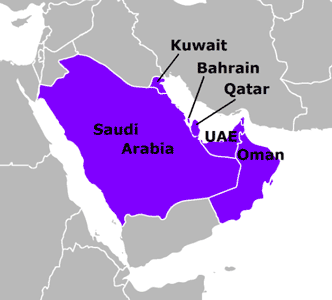
6. 日本企業への提言:
- 再生可能エネルギー対応
- 再生可能エネルギーに関して、日本は周回遅れの印象を受ける。エネルギーと環境問題は、日本経済にとっても死活的な課題である。
- 中東産油国が熱心に再生可能エネルギーを模索、付加価値の高い産業への投資などを進めている動きに対して、もっと積極的に対応する必要がある。
- オイルダラーによる事業投資、J/Vの推進、実証実験、R&D拠点の役割等(マスダール・シティはその実験構想の一つ)が考えられる。
- GCC諸国対策
- UAEは、その先進的な取り組み (New Dynamics)のショールーム的な存在。UAE自身が、GCCの中の経済特区的な役割を演じており、欧米・中印韓が極めて熱心にアプローチしている。UAEでの成功は、時間を経て、サウジアラビアなどGCCに拡大していく可能性がある。
- 石油開発自体も、1932年に、バーレーン島で発見されてから、同様の油田発見の可能性が期待され、アラビアン半島側で探査した結果、大規模な開発につながった歴史がある。
- 中東地域は、特に、エネルギー関連のテーマでは、一つのローカルではなく、グローバルな市場展開につながる”新産業オリンピックの場”となっている。大規模実験、資金や土地の提供、厳しい気候環境という環境下で成功すれば、他の地域での応用が見込める。
- 日本の中東へのコミット強化
- 中東各国では、親日的な国も多く、日本に対する潜在的な期待は大きい。 緻密で省エネルギー的なもの作り、アフターフォロー・サービスの真面目さなど、約束通りきちんと実行することに対する評価高い反面、意志決定が遅いことと、トップダウンの訪問による人的ネットワークがあまりにも稀薄で、現地の認知度が低い。中東経済エキスパートをもっと養成すべきである。欧米各国はもちろんのこと、中国・インドや韓国も大勢送り込んでいる。
- >Top Challenging SWOT:
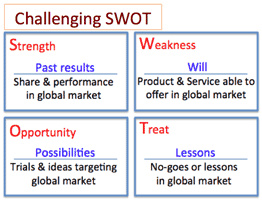
- At global business situation, the overall attitude should be more active. In case of making SWOT (Strength, Weakness, Opportunity, and Threat) analysis, we need to have bump up a notch rank more affirmative attitude in each category.
- Even in the case of failure, which could get valuable lessons from the failure like the case of Fukushima nuclear plants accident.
- SWOT積極版:
- グローバル市場では、各企業は現在および将来の可能性、グローバル市場での役割を、以下のように多面的にPRしている。いわば前向きなSWOT的情報合戦の場に日本企業はもっとグローバルな場面で日本の強み、特徴、あるいは過去の失敗事例でさえ教訓として、積極活用PRすべきである。特に、成長市場においては、いわばSWOTの各項目を一段ずつ積極的に表現するようなチャレンジ精神が必要である。
>Top 7. Middle-East looking the future:
- GCC countries of ME, particularly UAE is a promising area of next-generation business point d'appui. The reasons are:
- Crossroads of global market:
- GCC countries may wish to have persistent business cooperation rather than general trading relations; not only energy, but also construction, chemical, automobile, finance and engineering, etc.
- GCC countries looks like scramble crossing from the viewpoint of EU, US, China and India.
- Enormous oil dollar:
- Effective utilization of enormous oil dollar is the first priority, not only export of oil and gas, but also more value added business including nation-building considering 21C type of intelligent industry. Masdar City concept of UAE will be the typical one.
- The volume of Islamic finance counts from US$1 to 4 trillion, which prohibits interest in principle and pursues various types of financial services such as real transaction called Murabahah), lease (Ijarah), profit-loss sharing (Mudarabah) as well as investment (Musharakah).
- Centripetal forces of Islamic culture:
- Islamic society reinforces centrality by using softpower such as Islamic architecture, design, arts including drama, film, dance, song, poem, and so on; all backed by Islam.
- Media and network industries are intelligent industries:
- Qatar, Bahrain, UAE have awakened the importance and media industry, and are eager to bring up broadcasting in Arabic language.
- Sending information by Internet is quite active: contents by Arabic language is said affluent after English and Chinese. This trend contribute to pursue intelligent industry through using network.
- Islamic people are proud to develop Greek and Roman intelligence and propagated them to Europe. Algorithm is named after Muhammad ibn Musa al-Khwarizmi, Persian muslim mathematician。
- Expectations to Japanese companies:
- Japan has no traditional right and interest unlike Europe and US since colonial times. Japan can behave as neutral position like China and India.
- It will be great business opportunities to participate industrial Olympics held in this region having close contact with GCC countries.
- Direct involvement of Japanese manufacturers:
- Japanese trading companies play major function in this area on behalf of Japanese major manufacturers to import energy resources and export machinery, chemical, automobile, food and textile, etc., establish major trading partnership as an equally important as US and European market.
- GCC countries wish to have direct trade relationship with global enterprises having state-of-the-art technologies.
- Vast Arabic language sphere:
- Arabic language is lingua franca in this region: Islamic people master Arabic since childhood through reciting Quran.
- Arabic language is natively spoken in twenty or more countries, counting more than 200 million people, prevails several hundred million including India, Pakistan, and constitute as unifying base of the areas. It is one of six official language of UN.
- Japan located Far East should have ME specialists who work here as a franchise, which leads to the gateway to global development.
- Similarity of information and energy:
- Both energy and information look like similar; delivering value by constant flow of currency. They are difficult to store, may deteriorate, and need to maintain long range of network to deliver it, being required to deliver stably and universally at the competitive price.
- They are uneatable as themselves, but if we absorb and digest or utilize them properly, those are quite useful in business and life.
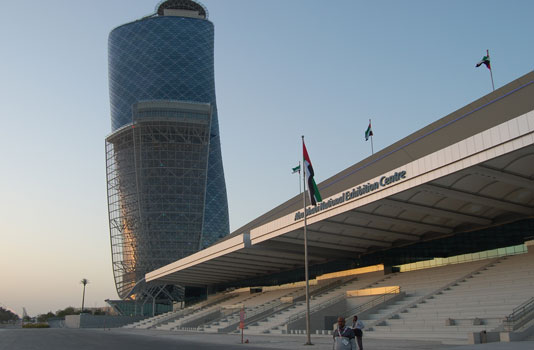
7. 未来に向かう中東:
- 中東地域、特にGCC諸国、その中でもUAEは、次世代のビジネス拠点としての有望地域である。その理由としては以下の通りである。
- グローバル市場の交差点:
- GCC諸国は、一時的な貿易関係よりも、永続的なビジネス提携への期待が大きい。エネルギーのみならず、建設、化学、自動車、金融、エンジニアリングなど。
- 欧米・中印の大手企業から見れば、GCC諸国は、スクランブル交差点に相当する。
- 巨大なオイルダラー:
- GCC諸国は、石油・ガスの輸出だけでなく、オイルダラーの有効活用を通じた付加価値ビジネス、とくに21世紀は知識産業を中心とした国造りに熱心で、UAEのマスダール・シティはその典型。
- イスラム金融の資金は1兆ドルとも4兆ドルとも言われており、金利は原則禁止されているのが、直接取引 (ムラーバハ)、リース (イジャーラ)、J/V (ムダーラバ)、あるいは投資 (ムシャーラカ)などさまざまな金融サービスが行われている。
- イスラム文化への求心力
- イスラム教を背景に、イスラム建築、デザイン、芸術 (演劇、映画、踊り、歌曲、詩など)多様な文化的なソフトパワー活用したイスラム社会の求心力は、ますます強まる傾向にある。
- メディア・ネットワーク産業は知識産業:
- GCCの中でも、カタール、バーレーン、UAEは、メディア産業に目覚め、アラビア語による放送局などの育成にも熱心である。
- GCCに限らずアラブ諸国でのインターネットの情報は、英語・中国語に次ぐ情報コンテンツの流通があり、今後ネットワーク産業を通じた知識産業を志向するものと思われる。
- イスラムの人々には歴史的にも、ギリシャ・ローマの知識を発展させ、欧州に伝搬させたという自負もある。アルゴリズムもイスラムの数学者がルーツ。
- 日本企業への期待:
- この地域において、日本は、伝統的に欧米のように植民地時代以来の利権がない反面、中立的に関与できる有利な立場にある。(中国、韓国も同様)
- 日本の大企業が、GCC諸国に拠点を持ち、グローバルなネットワークを維持することは、GCC諸国が主催する産業オリンピック的なビジネスチャンスに参画できることを意味する。
- メーカーによる直接関与:
- 日本は、主に大手商社が中心となって、この地域からエネルギーの輸入し、この地域が必要とする機械・化学品・自動車・食料・線維の輸出してきた。各商社も、この地域は米・中に匹敵する最大取引地域と位置づけてきた。
- GCC諸国としては、とくに最先端の技術力のあるグローバル企業との直接のビジネス関係構築を期待している。
- 広大なアラビア語圏:
- 子供の頃からのコーラン暗唱に裏付けられた共通語アラビア語は、二十数カ国2億人以上のネイティブと、この地域に浸透しているインド・パキスタンなど第二外国語の人口を入れると数億人になる。イスラム教と並んで、中東地域のまとまりの基盤となっており、国連公用語にも採用されている。
- 極東の日本から見れば、”ミドル・ウエスト”としてこの地域に拠点を持ち、中東の専門家を育成することで、グローバル展開のゲートウェイとして期待できる。
- エネルギーと情報との類似性:
- エネルギーも情報も、常に流れ続けることで価値を運ぶ。そのまま貯蔵することは難しいし、劣化する。運搬するためには長距離のネットワークの維持が必要である。そしていつも安定的にコストを安く、ユニバーサルに提供することを求められる。
- さらにそのまま食べることはできないが、うまく取り込んで消化・活用すれば次ぎの仕事・生活に役に立つ。
>Top 8. Power generation pros and cons:
- Here is a trial of comparison of pros and cons of various power generation method.
(Five degrees evaluation as to each factor)
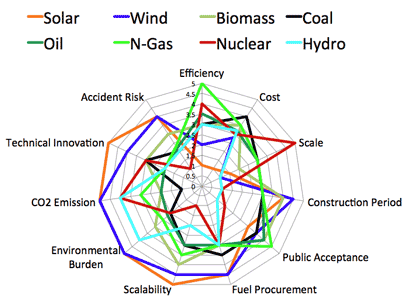 During the survey mission to WFES, here is a trial of my conclusion, considering the Fukushima nuclear plant accident, which has affected the change of mood at the conference, but the background data has not reflected the latest situation.
During the survey mission to WFES, here is a trial of my conclusion, considering the Fukushima nuclear plant accident, which has affected the change of mood at the conference, but the background data has not reflected the latest situation. - The actual evaluation, cost comparison in particular, varies according to the difference of government energy or power generation policy, as well as taxation, subsidies, and insurance. Cost comparison is rather difficult.
- Power generation policy is mostly domestic but the resources mostly depend globally.
- Furthermore, operation ratio varies between budget and actual figures. Even reality of the break-down figures are mostly not opened.
- As long as carbon emission is a global issue, energy policy of each country, particularly generation cost should be transparent, just like the cases of non-tariff negotiation. Nuclear power generation is required to trace more severely forl global security and safty consideration.
- Fuction of neural and authoritative organizations is getting important. As electricity is an industrial product, whose cost should to be determined by market price.
8. 発電源別比較:
- 発電源別比較
- 今回のWFESの講演・展示を参考に、エネルギー源別発電コストの私案を作成してみた。(要素毎の5段階評価)
- 実際には、原料調達の差に加えて、各国のエネルギー政策、発電政策により、国の関わり方が異なり、かつ税金・補助金・保険を含めた国別の事情の違いにより実際にはコストの比較はなかなか難しい。
- 発電は主に国内的だが、その資源は主に国際に依存している。
- さらに稼働率を想定値と実績値では相当異なり、その詳細は公表されないことも多い。
- CO2の課題が国際的な懸案である以上、各国の非関税障壁を巡る議論の場合と同様に、各国のエネルギー政策、特に発電コストの明示化が必要である。原発の場合はさらに国際的な安全性がより厳しく求められる。
- また、これらを評価する中立的な機関の役割も重要となる。究極は、電気も工業製品である以上、市場価格によって比較されるべきである。
>Top Energy essential issues:
- Energy issuses are very complicated: we must consider this issue from wider and longer range of viewpoints, considering next generations, or survival of our species:
- There are three major factors related to global energy issues:
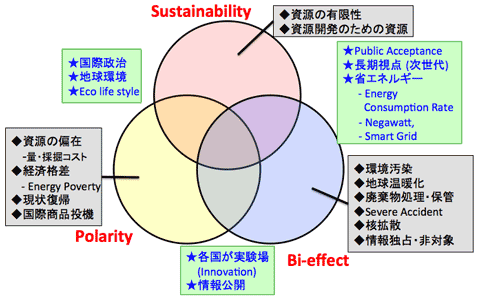
- Sustainability:
- Polarity:
- Bi-effect:
- Sustainability contains:
- finiteness of energy resources: there is controversy of limit of minable fossile resourves, asserting about 30 years or 100 years more. But it would be clear that either assertion never go beyond a millenium.
- Even solar energy has limit; but it wouldl continue several billion years more.
- Also we must notice that we need resources, mostly oil, to exploit other resources; eg., particularly in nuclear resources, we need oil to exploit, transport, enrich, facblicate, install the plant, dispose and control the waste almost by using oil energy.
- Polarity:
- Mineral resouces exist in a certain small minor areas, mostly in remote undevelopmed areas. Mining areas are usually within or adjacen to the reserves area for aboriginal people or national parks for valuable flora and fauna.
- There is a sever energy divide, or energy poverty issue: 1/5 of global population could not access to modern electricity as US mentions.
- Restitution is also serious issue. Backfilling of mined opencut preventing hazadous waste is iindispensable.
- Polarity of products causes speculation in money blooming game.
- Bi-effect:
- Fossil resources are bulky, which need large tunkers or long pipelines to deliver. There will be unavoidable servere accidential spillage.
- Nuclear wasre are much severe; living creatures cannot coexit with nuclear waste, which must be separated and strictly preserved for many generations.
- We must consider MTBF (Mean Time Between Failure) idea to handle energy. it is unavoidable that machines will deteriorate, human beings may fall into errors, and unlucky natural disasters may occurr as well as risks of war and terror.
エネルギーの本質課題:
- エネルギー問題は極めて複雑。
- 広く、かつ長期的視点で考える必要あり。
- エネルギーの課題3つの要素:
- 持続可能性
- 偏在性
- 副作用
- 持続可能性:
- エネルギー資源の有限性。化石燃料委についても論争あり。30年から100年以上。いずれにせよ千年はもたない。
- 太陽エネルギーですら有限ではあるが、太陽の寿命はまだ数十億年ある。
- また資源を採掘するには資源、特に石油が必要である。
- 原子力の場合でも、採掘、輸送、濃縮、加工、プラント建設、処理、廃棄物管理をほぼすべて石油によって賄う必要あり。
- 偏在性:
- 金属資源はごく一部の地域、特に途上地域に偏在。
- 副作用:
- 化石燃料は嵩張るので、輸送問題やそれに伴う事故がつきもの
- 核廃棄物はさらに困難。生命は本質的に放射能と共存しない。
- エネルギー源を考える場合MTBF (平均事故間隔)を考慮すべき。機械は劣化し、人間は間違いを犯す。さらに天災・戦争・テロのリスクもあり得る。
Comment
- >Top Energy issue is multidisciplinary; requiring energy resources development technology, geopolitical sense particularly ME countries, understanding of multinational major companies, as well as IT technology like smart grid or innovation of capacitor, etc.
- In particular to energy resources, there are wide range of physics and geology are required from solar resource and underground resources, from lightest photon to heaviest plutonium, from atmosphere, liquid and solid state of visible and invisible situation.
- Energy is difficult but matters.
- The author, specialized in geology, experienced PNC, Energy division and IT division of Itochu, also in NEC Soft, recongnizes the necessity to summarize this important theme with utmost energy.
- エネルギー問題は多分野・学際的である。エネルギー資源開発技術、地政学的センス、特に中東諸国、多国籍メジャー企業動向、さらにスマート・グリッドや蓄電技術などの進化を必要とする。
- 特に、エネルギー資源に関しては、広範な物理や地質の知識が必要となる。太陽の資源から地中の資源まで、最も軽い光子から最も重いプルトニウムまで、目に見える・見えない気体・液体・固体に至るまで。
- エネルギーは難しいが重要である。
- 地質学を専攻し、動燃、伊藤忠のエネルギーとIT部門、NECソフトに在籍し、豪州・中東に駐在した著者が、今こそこの問題に総括すべき時と自覚する。
Title |
World Future Energy Summit, Abu Dhabi 2012 |
世界未来エネルギーサミット |
|---|---|---|
Index |
||
Tag |
Energy mix; Energy poverty; Extended Reach Drilling, ERD; Desulfuriztion; Carbon Capture & Storage, CCS; Hydraulic Fracturing; Global Warming Potential, GWP; ARPA-E; Challenging SWOT |
|
Why? |
|
|
Original resume |
Japanese resume |
>Top 0. Introduction:
|
0. 序文:
|
>Top 1. Overview of UAE:
|
1. アラブ首長国連邦概略:
|
>Top 2. Key note of the first day:
|
2. 初日の基調講演:
|
|
|
>Top 3. Exhibition booth of each country:
|
3. 各国の展示ブース:
|
 |
|
>Top 4. Noteworthy lectures:
|
4. 注目すべき講演:
|
|
|
|
|
|
もしあなたが電力会社のCEOならどの燃料での発電所を建設するか
|
|
|
|
|
||||||||||||||||||||||
>Top Wind Power Generation:
|
|

|
 |
|
|
|
|
|
|
>Top Advanced Research Projects Agency - Energy (ARPA-E):
additional changes in Jan. 2011:
|
|
>Top 5. Masdar City:
|
5. マスダール・シティ(Masdar City):
|
>Top 6. Proposal to Japanese companies:
|
6. 日本企業への提言:
|
|
|
>Top 7. Middle-East looking the future:
|
7. 未来に向かう中東:
|
>Top 8. Power generation pros and cons:
|
8. 発電源別比較:
|
>Top Energy essential issues:
|
エネルギーの本質課題:
|
Comment |
|
|
